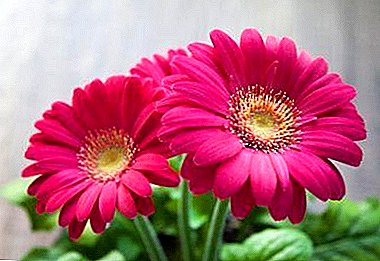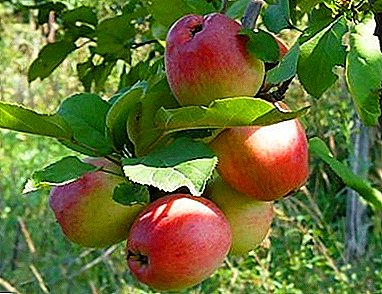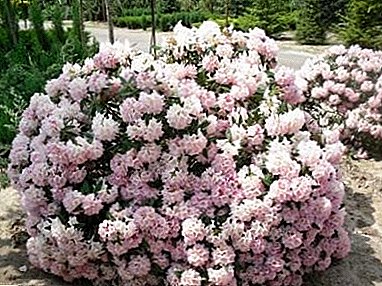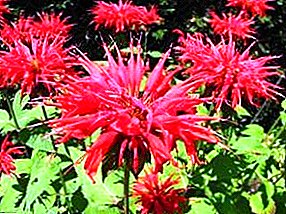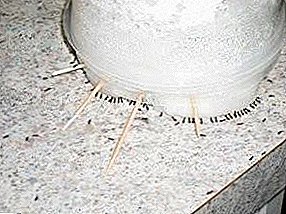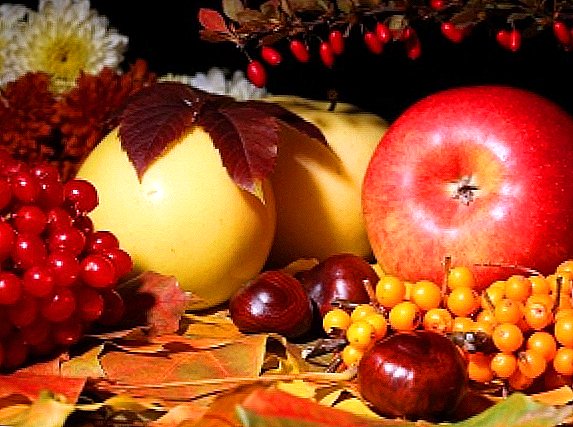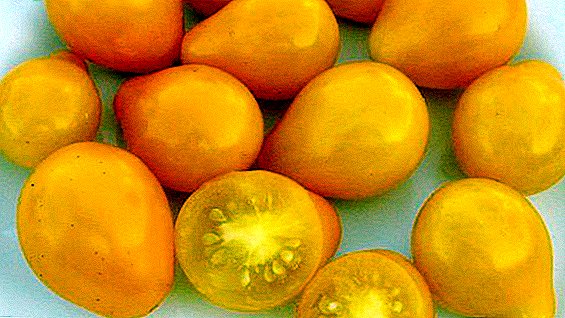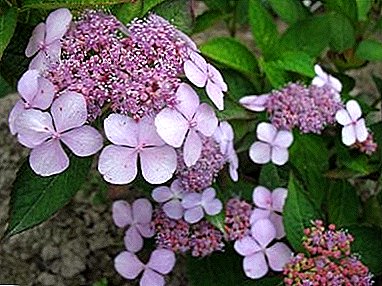
Hydrangeus serrata (Hydrangeaserrata) - type of garden hydrangea, sprawling undersized garden shrubs, pleasing the eye with variegation and shape of inflorescences.
Its name - Hydrangea (from the Greek. Hydor - water and angeion - a vessel) means "a vessel with water." The sawtooth shape of the leaves (serrata - from the Latin. "Gear") gave the name of the form.
Characteristics, descriptions and differences from other species
Root system
Spreading wide fibrous root system up to 40 cm deep. The large area of the suction surface and the shallow bedding of the root system determine the quick response of the plant to fertilizer and pollution from the soil.
Leaves
The length of the leaf is slightly less than that of the nearest large-leaved relatives - up to 12 centimeters. Oval, pointed at the ends, they have at the edges of the notch, resembling a saw. They are a business card and a distinctive feature of the serrate hydrangea.
Flowers
Type of inflorescence - corymboid panicle diameter up to 8 centimeters. In the center of the "panicle" there are a lot of small fertile variegated white-blue or white-pink flowers capable of cross-pollination. The edges of the inflorescence are decorated with larger four-leaf sterile flowers that do not have reproductive organs. After blooming, they have a monochromatic milky-pink or blue color.
Trunk
Strong branched bark of a bush is hidden under a magnificent hat of inflorescences and foliage and is almost not visible. He has height up to 1.5 meters, at the base of the strongest, low branches.

Wintering
Winter hardiness Hydrangea serrate increases over the years. Everything young shrubs without exception for the winter must take refuge.
Hydrangea feels more comfortable in southern winter, temperatures below -40 ° C will be extreme complicated. The southern climate is suitable or climate Central Russia with a winter temperature not lower than -25 ° C.
Ways of sheltering for the winter:
- To pile up and cover with a plastic bag - winters to -5 ° C.
- Tie a bush with a rope. Spud high and throw up sawdust, spruce spruce branches. Cover the top with several layers of plastic film and secure with wooden boards. This method will help to survive winter to -15 °.
- Maximum cut dry shoots. Highlight bundles of 1-2 branches, bend to the ground and secure with wooden brackets. Throw shrub with sawdust, spruce branches, dry leaves, cover with a sheepskin coat or an old plaid. Top lay several layers of polyethylene, fasten with boards or bricks. The method fits for winters -15 to -20 ° C.
Important! For maximum insulation, use a metal mesh frame that can be covered with old clothes. It is possible to impose a construction instead of a grid a brick. Such structures are suitable at -30 °.

Sorta
Hortensia serrated Preciosa
Spreading bush up to 2.5 meters in height. The flowers are barren greenish, pink or blue, by the fall are painted in crimson. Green leaves are burgundy in autumn. Prefers penumbra, moist acidic soil. Frost - up to -23 °.
Hydrangea Bluebird
Wide low spreading shrub height and width up to 1.5 m. In the inflorescence fertile flowers are red, purple with bluish stamens. Sterile flowers are white, blue, purple. Green and red leaves with a red handle. Loves wet soil and light. It carries a temperature of -18 °.
Hortensia serrated Wierle
A miniature bush with blue flowers. Green foliage in the fall becomes purple or burgundy. Picky It needs to maintain constant soil moisture, fertilizer, penumbra. Not hardy.
Care
Landing
Held from April to May into a hole with a depth of 10 cm greater than the length of the root system. Before planting, the soil is loosened, mineral fertilizers, peat, sand, and humus are added to the well. The optimal distance between shrubs is at least 1 meter. Within a radius of 3 meters should not be large moisture-loving plants that can compete with hydrangea for moisture.

Light mode
The penumbra, diffused light. It is preferable to plant against a wall or fence, which will serve as a shelter for hydrangeas, both in summer and in winter. It feels great under a roof shed, limiting the direct sun rays that are harmful to the bush. Win-win will be the use of a folding canopy, when the sun is at its zenith.
Thermal mode
Garden varieties have mastered a wider temperature range than indoor - from -2 ° to + 25 °. To reduce the detrimental effect of high temperatures in the summer can be two or three times a day by watering and folding canopy. It must be remembered that the main reference point to start preparing hydrangeas for wintering is night temperature below -2 °.
Watering
Hydrate hydrangea is moisture-loving and requires abundant daily watering. In dry summers it is especially important to maintain a constant moderate soil moisture. With + 30 ° and above is shown triple wateringat + 25 ° - double. It is possible to use sprinklers.
Fertilizer / feeding
Fertilizer is carried out three times a year: during planting, in the "bud" period and at the beginning of flowering. The simplest fertilizer is a mixture of peat, humus and dry leaves in proportion 2:1:2. When planting the mixture is filled with free root space in the hole.
During periods of bud ripening and flowering, fertilizer is introduced into the root space under the shrub. To give it a liquid consistency, you need to fill the five-liter bucket half-filled with a mixture to the brim with diluted with water compost.
Nitrogen-containing fertilizers are applied strictly according to the instructions, they no need to abuseif you want to get plenty of flowering.
Top dressing is carried out once a week. In the role of feeding is used compost, dry foliage.
To loosen the soil, sawdust and sand are added to the compost.
Bloom
The flowering period is July and August.
Interesting! The soil environment is capable of influencing the shade of hydrangea flowers. The alkaline soil gives the inflorescences warm pink shades, while on the acidic soil the flowers become bluish.
Every three days, water one side of the bush with a slightly pink solution of potassium permanganate, and with aluminum sulfate solution - the other and get on one plant both blue and pink flowers. The composition of the solution: 2-3 grams of powder per 1 liter of water.
Breeding
Breeding hydrangea seeds and cuttings.
Cuttings are prepared before budding. To do this, from the young branch, select the area with 1-2 knots and leaves. Without a distance from the top node at an angle of 90 ° cross the branch. Under the lower node of the branch cross obliquely, cut off the massive leaves, leaving several small ones.
Planted at a depth of 1-2 cm handle handle indole acetic acid and daily spray and water.
Pruning
Run in September before hibernation. For this, shears remove 2-3 upper nodes, level the “cap” of the bush. Branches without inflorescences and old dried leaves and branches are cut off.
Autumn pruning is requiredits purpose is reduce the area of evaporation of moisture at wintering plants. In the summer, the bush is trimmed at will - to give shape and for greater tillering. Once every 2 years, radical cutting off dead shoots is required.
Diseases
The serrate hydrangea derived by breeders is resistant to pests.
Chlorosis and powdery mildew are common diseases.
Sick chlorosis leaves fade and brighten, streaks remain the same color. Plant 2 times a day sprayed a solution of potassium nitrate and iron vitriol. The composition of the mixture: 4 grams of vitriol and potassium nitrate on 1 liter of water.
Mealy dew leaves on leaves yellow and brown-brown spots or specks and white powdery scurf. For treatment twice a day, the affected leaves and stems are sprayed with a mixture of 10 g household soap shavings and 1.5 g copper sulfate on 1 liter of water.
Spider mite affects the lower part of the leaf, is afraid of ultraviolet. The leaves turn yellow, dull and fall as a result of the disease. It is detected by a brown spider web. Struggling with mite spraying leaves with thiophos.
Grateful favorite
The most important links in the care of hydrangeas are proper wintering, feeding, acidifying the soil and regular watering. In exchange for your care, a perennial bush will bring inspiration and its extraordinary beauty.
A photo
See more photos of hydrangea:






